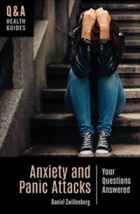Everything You Need To Know About Anxiety
Anxiety disorders are common, treatable, and can be managed: Learn the skills needed to control anxiety and live a healthy, happy life
August 25, 2023
When we think of “anxiety,” we tend to think about feeling stressed out.
Actually, anxiety is our body’s reaction to a threat to our well-being. Without anxiety, we would not react when we are in danger, and we likely wouldn’t be alive today without it.
However, anxiety can be so much more than whether or not we need to run away from a situation. Since we’re primed to survive, our minds assume that more things are threats to us than they are—which can lead us to be more anxious than needed.
The truth is that all humans experience anxiety. For many, the anxiety can feel unbearable. Approximately 19% of adults in the United States struggle with anxiety every day.
Having anxiety, or being diagnosed with an anxiety disorder, doesn’t mean someone is weak. With the right care, they can become stronger than their anxiety and lead happy, successful lives.
Keep Reading To Learn
- What anxiety is and how it can impact your day-to-day
- The signs and symptoms of different anxiety disorders
- The diagnosis and treatment of anxiety
So What Exactly Is Anxiety?
Anxiety is our body’s normal reaction to stress. When we’re presented with potential danger, our bodies respond to that stress.
Fear is a similar emotional response. Fear is the body’s response to a real or perceived imminent threat, and anxiety is our body—and mind—anticipating a future threat.
For example, if you’re starting a new job, waiting for test results from a doctor, or driving in bad weather, you may feel anxious. This is a normal reaction to our emotions and happens to everyone. When anxiety stops being temporary fear or worry, it may be a sign that help is needed.
A person who has an anxiety disorder may always be anxious or easily become anxious about many things. Temporary fear or worry is normal, but if the feelings associated with anxiety disorders linger, they can continue to get worse over time.
Through understanding the condition and seeking the right treatment, anxiety can be managed.
Watch Now!
Our friends at ADAA help us understand anxiety and how to know when to seek help
Understanding the Many Anxiety Disorders—And Their Symptoms
While the phrase “I’m anxious” is spoken often, the type of anxiety that someone is experiencing can be hard to pinpoint. Many types of anxiety can impact everyday activities, like work, school, and relationships.
The following is not an exhaustive list of every disorder and symptom. If you feel that you or a loved one is experiencing any of the following, please reach out to your care providers to ensure that the right steps are being taken to support your mental health.
Generalized Anxiety Disorder
Generalized anxiety disorder (GAD) is extremely common, experienced by nearly one in eight people in the U.S.
GAD is known for a feeling of constant anxiety and worry about daily activities or events. This anxiety happens more days than not and occurs for at least six months.
Someone with GAD may feel as if they have no control over their worry or find themselves being overly concerned about money, health, family, work, or other daily occurrences. Sometimes, the thought of how to get through the day is enough to cause anxiety.
Many folks who have generalized anxiety disorder recognize that they are in a cycle of worry or that their anxiety is worse than the situation calls for. The challenge with GAD, though, is that the person doesn’t know how to stop the cycle of worry or feels that it’s out of their control.
Many people who are diagnosed with GAD also have co-occurring conditions, including depression, substance use, post-traumatic stress disorder (PTSD), and obsessive compulsive disorder (OCD).
Generalized anxiety disorder has both physical and mental symptoms, with most people experiencing some but not all symptoms. If you or someone you know is experiencing these symptoms, please reach out to your primary care provider or someone on your care team.
Physical symptoms include but are not limited to:
- Restlessness, feeling keyed up, or feeling on edge
- Feeling easily fatigued
- Muscle tension, aches, or soreness
- Sweating
- Accelerated heart rate, shortness of breath, or dizziness
- Stomach issues, including nausea and diarrhea
- Trembling, twitching, feeling shaky
- Sleep disturbances, including difficulty falling or staying asleep or not feeling well-rested
Mental symptoms include but are not limited to:
- Excessive anxiety or worry about various events or activities, occurring more days than not, for at least six months
- Difficulty controlling the worry
- A sense of impending danger, panic, or doom
- Irritability
- Difficulty concentrating, or mind going blank
- Difficulty remembering things
Panic Disorder
Panic disorder is a rush of anxiety that comes out of the blue that makes people feel like they’re going crazy, having a heart attack, or going to die. Though it typically develops in folks between 18 and 35, it can occur at any time. Women are nearly twice as likely to develop panic disorder as men.
Unlike anxiety, which often has clear triggers, panic typically is sudden, uncontrollable fear or anxiety. This can often cause impulsive behavior.
The fear response is one of the largest differentiators between panic disorder and other anxiety disorders. In panic disorder, the person is fearful of the fear they’re feeling.
A person with panic disorder may feel terror even if there is no real danger. Many individuals with panic disorder have explained that their panic feels like they are losing control.
Panic happens quickly and unexpectedly and typically only lasts a few minutes. Anxiety tends to appear gradually and can last for extended periods.
Panic attacks can happen to anyone at any time. But people with panic disorder have recurring attacks, and they can’t be explained by other mental health conditions.
Individuals with panic disorder will often change their behavior related to attacks to try and avoid another attack from happening. They’ll often be concerned or worried about additional panic attacks as well as the consequences—like feeling they are losing control or having a heart attack.
This constant concern and attempts at avoiding future attacks can majorly impact areas of the person’s life. It can lead to the development of additional mental health issues, like agoraphobia, which is a fear of being in certain places or situations, such as being in a crowd.
Some physical symptoms of panic disorder include:
- Rapid heartbeat or a pounding heart
- Sweating
- Trembling or shaking
- Chest pain
- Shortness of breath
- Dizziness, unsteadiness, or lightheadedness
- Stomach distress
Some of the mental symptoms of panic include:
- Feeling detached from oneself or reality
- Fear of losing control
- Fear of dying
- Feelings of impending doom
The Difference Between Panic and Anxiety
A little worry can be healthy. Understanding the difference between normal worries, unhealthy anxiety, and panic can be the key to getting help when you need it.

Social Anxiety Disorder
Social anxiety disorder is a condition where folks are fearful of being judged or embarrassed in social situations. Often, they’ll endure a social situation but will deal with intense feelings of fear or anxiety. This may be considered an anxiety disorder if the social phobia lasts at least six months.
Approximately 7% of the U.S. population is estimated to have a social anxiety disorder, and its occurrence tends to decrease in older populations.
It’s slightly more commonly diagnosed in females and adolescents. Most people experience an onset of symptoms between the ages of eight and 15 years old.
One of the hallmark traits of social anxiety is a fear of being negatively evaluated by others. Often the person anticipates that they’ll be judged as anxious, weak, stupid, boring, unlikable, or another negative trait.
With this disorder, social situations almost always cause fear or anxiety that’s often out of proportion to the real risk of being viewed negatively. With social anxiety, many try to avoid social situations and will do so consistently.
Some of the symptoms of a social anxiety disorder include:
- Fear or anxiety about one or more social situations where the person is exposed to possible scrutiny by others
- Shyness or being withdrawn in social situations
- Blushing
- Sweating
- Being closed off in conversation or revealing very little about oneself
- Trembling or shaking
- Overly rigid body posture
- Poor eye contact
- Softly speaking
- Stumbling over one’s words
- Staring
In children, additional physical symptoms include:
- Crying
- Tantrums
- Freezing in place
- Clinging to a parent or guardian
- Shrinking back
- Refusal to speak in social situations
Anxiety Screening
Online screening is the quickest way to find out if you should be concerned about your anxiety.
Separation Anxiety
Some anxiety about separating from loved ones is normal. Separation anxiety disorder is excess concern, dread, or worry about actual or anticipated separation from someone a person is emotionally attached to. Separation anxiety is a common anxiety disorder in kids but is also present in adults.
Attachment figures for children are usually adults, such as parents. In adults, this could be any loved one, from a romantic partner to a child, or even a pet. Typically, the individual is afraid that something bad will happen to the person they care about while they’re not present.
Separation anxiety disorder can have a huge impact on all areas of life. In adults, it can lead to social isolation, inability to work, or relationship troubles.
Phobias
Phobias are fears of objects or situations which can be disruptive to a person’s life. Some more common phobias are:
- Hemophobia (fear of blood)
- Trypanophobia (fear of needles or medical procedures involving injections/hypodermic needles)
- Agoraphobia (fear of places or situations that might cause panic/feeling trapped, helpless, or embarrassed)
Fear associated with phobias is usually present for six months or longer. Depending on the type of phobia, they can be disruptive to daily life activities, such as going to work, traveling, and socializing.
Obsessive Compulsive Disorder
Often thought of as an anxiety disorder, obsessive compulsive disorder (OCD) is a condition where the person experiences unwanted and intrusive thoughts. These thoughts are followed by feelings of anxiety, uncertainty, and occasionally, panic.
This condition is much more than occasionally obsessive thoughts or actions. With OCD, the person may struggle with obsessions or compulsions daily.
People with OCD get stuck in a cycle of obsessions and compulsions that impact the way they think and behave.
If the condition goes unaddressed, these cycles can impact many aspects of their personal, educational, social, and professional lives.
OCD tends to first appear between the ages of 8 and 12 as well as late teens or early adulthood. OCD equally impacts all genders, races, ethnicities, and backgrounds and affects an estimated two to three million adults in the U.S.
Just because someone experiences an obsession or compulsion doesn’t mean they are living with OCD.
In general, people with OCD:
- Spend at least one hour every day dealing with obsessions or compulsions
- Experience disruptions to daily life and/or relationships because of obsessions and compulsions
- Cannot control their thoughts or behaviors, even when they impact daily life in a negative way
- Experience relief from anxiety when performing a compulsion but don’t get any pleasure out of the activity
Most people experience unwanted and intrusive thoughts from time to time. With OCD, though, these thoughts trigger an extreme reaction that affects day-to-day functioning and activities.
Living With Anxiety
Mary was struggling with anxiety and other mental health challenges, but treatment at McLean—and the support of her sister—turned her life around.
What Causes Anxiety?
In the U.S., nearly one-third of people will experience an anxiety disorder in their lifetime. Though the disorders are often diagnosed in early adolescent years, they can appear at any time.
There’s a biological component to anxiety. Neurotransmitters are chemicals in our brain that send messages about how we’re supposed to feel. If they aren’t sending the right messages at the right time, people may be more likely to experience anxiety.
Research has shown that both genetic and environmental factors can contribute to a higher risk of developing an anxiety disorder. Some risks for developing anxiety disorders include but are not limited to:
- Exposure to stressful events in early childhood or adulthood
- Family history of anxiety or other mental illnesses
- Unpredictable bouts of shyness in childhood
Some physical conditions can also worsen the symptoms of anxiety. A heart arrhythmia, caffeine intake, or medication side effects can create or increase the severity of anxiety symptoms.
If You Need Help for Anxiety, Seek It
Anxiety is common, but only a third of people with an anxiety disorder seek help. If you are experiencing prolonged anxiety or anxiety that causes you significant distress or impairs your ability to function, it may be time to seek help.
If you experience any of the following symptoms for longer than six months, you should consider seeking help from a health care professional:
- Excessive anxiety or worry about various events or activities, occurring more days than not, for at least six months
- Difficulty controlling the worry
- Loss of interest in things you used to enjoy
- Spending increased time alone or avoiding social events
- Suicidal ideation (thinking about harming yourself)
- Experience disruptions to daily life and/or relationships because of obsessions and compulsions
- Cannot control your thoughts or behaviors even when they impact daily life in a negative way
- A sense of impending danger, panic, or doom
- Difficulty concentrating, remembering things, or mind going blank
- Fear or anxiety about one or more social situations where the person is exposed to possible scrutiny by others
Anxiety disorders should be diagnosed by licensed clinicians, such as mental health professionals or primary care providers.
If your anxiety has physical symptoms, a provider may run lab tests during the evaluation to make sure that other conditions aren’t causing symptoms. X-rays, scans, or other imaging studies may also be required before a diagnosis is made.
The provider will ask a series of questions from a standardized questionnaire about anxiety disorders or may have the patient complete a self-assessment of symptoms.
Anxiety often occurs alongside other mental health conditions. Conditions like depression, substance misuse, PTSD, and OCD may also be present. If this is the case, additional screenings and treatment may be required.
Understanding Anxiety in Kids & Teens
Anxiety is the body’s normal stress response. But too much anxiety can be hard to handle. Learn how to recognize signs and symptoms and how to seek help for children and teens.

How Is Anxiety Treated?
Common treatments for anxiety include therapies and medication if needed. Like each person who experiences anxiety, all treatment options are unique and can be tailored to the person seeking care.
Therapies
Anxiety has multiple therapy options for treatment, including talk therapy, cognitive behavior therapy (CBT), acceptance and commitment therapy (ACT), and interpersonal therapy (IPT).
Talk therapy helps treat people with many mental health conditions. They may be solo sessions, with parents or families, or in a group. Patients can work with a therapist to understand and control their anxiety.
CBT is a very effective treatment. It helps the patients think and behave differently when experiencing anxiety. It can also help patients identify and change negative thought patterns.
ACT is a behavioral therapy that applies self-acceptance with mindfulness practices. It helps achieve psychological flexibility. As a result, patients better manage their anxiety and stay present in the moment.
IPT is a shorter-term treatment for anxiety. In IPT, patients learn to understand underlying interpersonal issues to better express emotion.
Medication
Different types of medications can be used to treat anxiety. Using medication can be especially helpful in reducing anxiety symptoms when beginning therapy.
Antidepressant medications, known as selective serotonin reuptake inhibitors, can help relieve anxiety symptoms. They are also used to reduce depression symptoms that can often occur alongside anxiety.
Some medications aren’t effective immediately at lowering anxiety. It may take anywhere from two to six weeks for a person to feel a difference.
If you are put on a medication for your anxiety, don’t stop taking it unless you are told to. Many people stop taking medication for anxiety once they start feeling better. This is simply a sign that it is working—and your symptoms can return if you stop taking it.
It’s important for you and your doctor to discuss:
- The benefits and side effects of each
- The risk of side effects based on other conditions or your medical history
- If medication will require other lifestyle changes
- If there will be any effects to any other medication you may be taking
Lowering Stress
Stress management, when practiced alongside other anxiety-lowering methods, can be very effective. Meditation and deep breathing techniques can help calm your nervous system, which lowers anxiety and enhances the effects of therapy.
Other helpful strategies to lower stress include:
- Taking time every day to unwind, including screen-less time
- Limiting caffeine intake, especially after noon
- Exercise
- Healthy sleeping patterns, including having a regular bedtime every day
- Learning your anxiety triggers
Learn more about stress management in this webinar with McLean’s Dr. Chris Palmer. Watch now on demand!
Anxiety Is Treatable—And Manageable
Don’t lose hope!
Anxiety disorders are far more common than many realize. If you feel that you or a loved one may have anxiety, consider seeking help from a mental health professional.
It may be difficult for others to understand if they haven’t experienced it themselves. By explaining that we all have anxiety—some of us just have more of it than others—we can aid others in understanding their anxiousness.
Anxiety is a chronic illness that many believe will get better on its own. That’s not the case. However, it’s manageable, common, and nothing to be embarrassed or scared of.
Contact your care primary care provider or a mental health facility like McLean to find the care that you—or a loved one—may need.
Let us help you find the care that’s right for you. McLean offers world-class anxiety treatment for children, teens, and adults. Contact us today at 617.855.3141 to learn more about treatment options.
Want More Info?
Looking for even more information about anxiety? You may find these resources helpful.
Interesting Articles and Videos and More
Learn more about anxiety and what you can do if you or a loved one is displaying signs of anxiety or related disorders.
- Video: Become Friends With Your Anxiety
- Video: Expert Answers to Your Burning Questions About Anxiety
- Everything You Need To Know About Stress
- Why You Put Things Off Until the Last Minute
- Video: Managing Anxiety and Stress in the Workplace and at Home
- Diet and Mental Health: How Nutrition Shapes Your Well-Being
- Fear, Anxiety, and Phobias: What You Need To Know
- Everything You Need To Know About OCD
- Everything You Need To Know About ADHD
- Video: Sensory-Focused Strategies to Manage Daily Anxiety
- Find all of McLean’s resources on anxiety and OCD
Helpful Links
These organizations may also have useful information:
Anxiety and Depression Association of America
An organization dedicated to increasing awareness and improving the diagnosis and treatment of anxiety disorders in children and adults.
The Child Anxiety Network
This organization aims to provide thorough, user-friendly information about child anxiety. They also offer direction for those who are not sure where to turn when they think their child or a child they know may need professional help to cope with anxiety.
Books About Anxiety

Find Your Fierce
by Jacqueline Sperling, PhD
(Magination Press/American Psychological Association, 2021)

Stuff That’s Loud: A Teen’s Guide to Unspiraling When OCD Gets Noisy
by Ben Sedley and Lisa W. Coyne
(New Harbinger, 2020)

Anxiety and Panic Attacks: Your Questions Answered
by Daniel Zwillenberg
(Greenwood, 2018)



